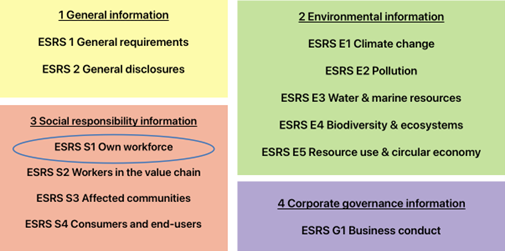This text is part of the series of brief articles that HållbarTillväxt AB has created to explain, simplify and explore the various steps that are currently most relevant in the area of sustainability; CSRD and ESRS. The ESRS consists of a total of 12 separate documents, 2 of which relate to general and comprehensive information (ESRS 1 and 2). The remaining 10, so-called topical standards, deal with various sustainability issues divided into environment, social responsibility and corporate governance – in English Environment, Social and Governance, abbreviated ESG. Fulfilment of the new requirements in CSRD and reporting according to ESRS is based on the involvement of all functions in a business, including the board and management. The board is ultimately responsible for sustainability reporting just as it is for financial reporting. Like the financial report, the sustainability report must now also be reviewed by an external auditor.

The new ESRS standard affects the way information is reported and places new demands on the review of companies’ operations. The new requirements set within ESRS S1 – Own workforce are more comprehensive than previous accounting requirements and involve transparent reporting of the conditions for the company’s employees. One of the purposes of the standard is to make it understandable to what extent a company follows international and European guidelines as well as conventions for human rights and labour law. This concerns, among other things, the UN’s general guidelines on human rights, which are the central ILO-conventions and the OECD’s guidelines for multinational companies.
Definition
Own workforce includes employee workers at the company but also the so-called non-employee workers. Non-employee workers are personnel who work in direct connection with the company, for example consultants, employees from employment placement agencies (NACE code 078) or through so-called outsourcing. These employees are thus also reported as part of the company’s own workforce. An important note is that subcontractors and customers are not covered in the company’s own workforce but are treated and reported on according to ESRS S2 – Workers in the value chain.
What should be reported?
ESRS S1 – Own workforce contains disclosure requirements (DR) in a variety of areas regarding workers’ circumstances, conditions and rights. Employers must be prepared to, in addition to details on the number of employees, also report on the employees’ terms of employment, working hours and wages. Furthermore, information must be provided about the own workforce’s access to information, freedom of association, consultation, collective agreements and participation. Information must also be given regarding the company’s work toward gender equality, health and safety in the workplace, work-life balance and how to prevent child labour, forced labour, discrimination, violence and harassment in the business. The work with ESRS S1 primarily involves detailing the company’s consequences, risks, and opportunities concerning its workforce and what different routines, policies, measures and goals exist or have been adopted to manage the circumstances and conditions of the workforce.
Which companies are covered and when?
For Swedish employers, large parts of the reporting requirements within ESRS S1 are already familiar, for example reporting the proportion of sick leave and staff turnover. Large companies, which are defined as companies with more than 750 employees, must report on all disclosure requirements (DR) that apply to their own workforce during the first year. For non-employed workers, certain phased-in options are available, allowing you to build a stronger foundation before reporting requirements come into effect the following year. In the first year, companies with less than 750 employees may omit all the information described in the disclosure requirements for ESRS S1, i.e. all disclosure requirements. There are additional opportunities for all companies, regardless of size, to omit certain information during the first year. Examples of such information are certain specific data relating to non-employees, collective bargaining, social protection, employees with disabilities, education and skills development and work-life balance.

Photo: Scott Blake, Unsplash
HållbarTillväxt’s recommendations for companies:
1. The materiality assessment
Often the topic of a company’s own workforce ends up in the Human Resource department. Therefore, it is important that HR is directly involved in the work with the company’s overall double materiality assessment. Employees contribute to the company’s business revenue and can represent both opportunities and risks, potentially having a significant impact on sustainability. Companies that identify their own workforce as a significant area must therefore report according to the information requirements and data points described in ESRS S1 that are deemed to have an important impact on the company.
- The gap analysis
Once the company has assessed which sustainability issues are essential and identified the disclosure requirements (DR) for these issues according to the standard, it begins mapping the current situation. What linked relevant information is available? Where is this information? What governing and reporting documents does the company have that support the materiality and thus must be reviewed? If there is any missing information or control process, if there is a gap, this must be closed. Processes, working methods, routines and documents are updated, information is collected and structured. In practice, this means that a gap analysis is carried out, highlighting the company’s current policies, processes, reporting and sustainability data in order to clarify which information is already available and what is missing in relation to the new standard’s disclosure requirements.
- The reporting and possible measures
After all the data has been collected and processed, the company as a whole must be evaluated. A transparent company has a clear competitive advantage. In this section, questions such as: Are there equal salaries between men and women in the same position? How is the employees’ well-being ensured over time in and outside the workplace? Is the skills development of employees and non-employees prioritised? Do employees have the mandate required to carry out the work? All of these are crucial questions, especially in the context of recruitment. The company’s sustainability efforts can be the key to the next generation choosing to support your brand.
© HållbarTillväxt AB 2024

